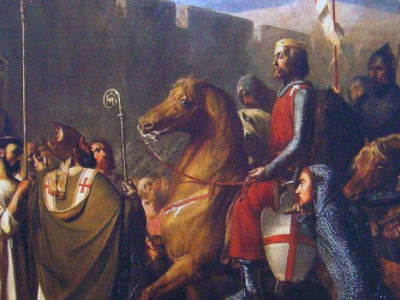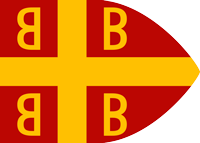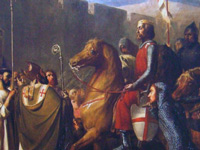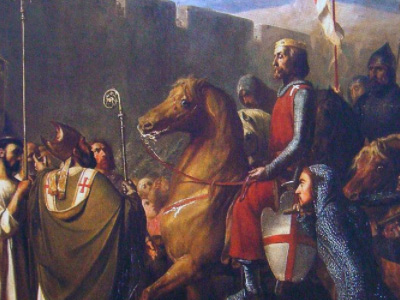First Crusade (1095–1099)

People's Crusade
The great French nobles and their trained armies of knights, however, were not the first to undertake the journey towards Jerusalem. Urban had planned the departure of the first crusade for 15 August 1096, the Feast of the Assumption, but months before this, a number of unexpected armies of peasants and petty nobles set off for Jerusalem on their own, led by a charismatic priest called Peter the Hermit. Peter was the most successful of the preachers of Urban's message, and developed an almost hysterical enthusiasm among his followers, although he was probably not an "official" preacher sanctioned by Urban at Clermont.
A century later he was already a legendary figure; William of Tyre believed that it was Peter who had planted the idea for the crusade in Urban's mind (which was taken as fact by historians until the 19th century). It is commonly believed that Peter's followers consisted of a massive group of untrained and illiterate peasants who did not even have any idea where Jerusalem was, but indeed there were many knights among the peasants, including Walter Sans Avoir, who was lieutenant to Peter and led a separate army.
Lacking military discipline, in what likely seemed to the participants a strange land (Eastern Europe), Peter's fledgling army quickly found itself in trouble despite the fact they were still in Christian territory. The army led by Walter fought with the Hungarians over food at Belgrade, but otherwise arrived in Constantinople unharmed. Meanwhile, the army led by Peter, which marched separately from Walter's army, also fought with the Hungarians, and may have captured Belgrade. At Nish the Byzantine The Byzantine Empire, also referred to as the Eastern Roman Empire or Byzantium, was the continuation of the Roman Empire primarily in its eastern provinces during Late Antiquity and the Middle Ages, when its capital city was Constantinople. It survived the fragmentation and fall of the Western Roman Empire in the 5th century AD and continued to exist for an additional thousand years until the fall of Constantinople to the Ottoman Empire in 1453. governor tried to supply them, but Peter had little control over his followers and Byzantine troops were needed to quell their attacks. Peter arrived at Constantinople in August, where his army joined with the one led by Walter, which had already arrived, as well as separate bands of crusaders from France
The Byzantine Empire, also referred to as the Eastern Roman Empire or Byzantium, was the continuation of the Roman Empire primarily in its eastern provinces during Late Antiquity and the Middle Ages, when its capital city was Constantinople. It survived the fragmentation and fall of the Western Roman Empire in the 5th century AD and continued to exist for an additional thousand years until the fall of Constantinople to the Ottoman Empire in 1453. governor tried to supply them, but Peter had little control over his followers and Byzantine troops were needed to quell their attacks. Peter arrived at Constantinople in August, where his army joined with the one led by Walter, which had already arrived, as well as separate bands of crusaders from France Kingdom of France is the historiographical name or umbrella term given to various political entities of France in the medieval and early modern period. It was one of the most powerful states in Europe since the High Middle Ages. It was also an early colonial power, with possessions around the world. Colonial conflicts with Great Britain led to the loss of much of its North American holdings by 1763. The Kingdom of France adopted a written constitution in 1791, but the Kingdom was abolished a year later and replaced with the First French Republic., Germany, and Italy. Another army of Bohemians and Saxons did not make it past Hungary before splitting up.
Kingdom of France is the historiographical name or umbrella term given to various political entities of France in the medieval and early modern period. It was one of the most powerful states in Europe since the High Middle Ages. It was also an early colonial power, with possessions around the world. Colonial conflicts with Great Britain led to the loss of much of its North American holdings by 1763. The Kingdom of France adopted a written constitution in 1791, but the Kingdom was abolished a year later and replaced with the First French Republic., Germany, and Italy. Another army of Bohemians and Saxons did not make it past Hungary before splitting up.
This unruly mob began to attack and pillage outside the city in search of supplies and food, prompting Alexios to hurriedly ferry the gathering across the Bosporus one week later. After crossing into Asia Minor, the crusaders split up and began to pillage the countryside, wandering into Seljuq territory around Nicaea. The greater experience of the Turks was overwhelming; most of this group of the crusaders were massacred. Some Italian and German crusaders were defeated and killed at Xerigordon at the end of August. Meanwhile, Walter and Peter's followers, who, although for the most part untrained in battle but led by about 50 knights, fought a battle against the Turks at Civetot in October. The Turkish archers destroyed the crusader army, and Walter was among the dead. Peter, who was absent in Constantinople at the time, later joined the main crusader army, along with the few survivors of Civetot.
At a local level, the preaching of the First Crusade ignited the Rhineland massacres perpetrated against Jews, which some historians have deemed "the first Holocaust". At the end of 1095 and beginning of 1096, months before the departure of the official crusade in August, there were attacks on Jewish communities in France and Germany. In May 1096, Emicho of Flonheim (sometimes incorrectly known as Emicho of Leiningen) attacked the Jews at Speyer and Worms. Other unofficial crusaders from Swabia, led by Hartmann of Dillingen, along with French, English The Kingdom of England was a sovereign state on the island of Great Britain from about 927, when it emerged from various Anglo-Saxon kingdoms, until 1 May 1707, when it united with Scotland to form the Kingdom of Great Britain. The Viking invasions of the 9th century upset the balance of power between the English kingdoms, and native Anglo-Saxon life in general. The English lands were unified in the 10th century in a reconquest completed by King Æthelstan in 927., Lotharingian and Flemish volunteers, led by Drogo of Nesle and William the Carpenter, as well as many locals, joined Emicho in the destruction of the Jewish community of Mainz at the end of May. In Mainz, one Jewish woman killed her children rather than see them killed; the chief rabbi, Kalonymus Ben Meshullam, committed suicide in anticipation of being killed. Emicho's company then went on to Cologne, and others continued on to Trier, Metz, and other cities. Peter the Hermit may have been involved in violence against the Jews, and an army led by a priest named Folkmar also attacked Jews further east in Bohemia. Emicho's army eventually continued into Hungary but was defeated by the army of Coloman of Hungary. His followers dispersed; some eventually joined the main armies, although Emicho himself went home. Many of the attackers seem to have wanted to force the Jews to convert, although they were also interested in acquiring money from them. Physical violence against Jews was never part of the church hierarchy's official policy for crusading, and the Christian bishops, especially the Archbishop of Cologne, did their best to protect the Jews. A decade before, the Bishop of Speyer had taken the step of providing the Jews of that city with a walled ghetto to protect them from Christian violence and given their chief Rabbis the control of judicial matters in the quarter. Nevertheless, some also took money in return for their protection. The attacks may have originated in the belief that Jews and Muslims were equally enemies of Christ, and enemies were to be fought or converted to Christianity. Godfrey of Bouillon was rumoured to have extorted money from the Jews of Cologne and Mainz, and many of the Crusaders wondered why they should travel thousands of miles to fight non-believers when there were already non-believers closer to home. The attacks on the Jews were witnessed by Ekkehard of Aura and Albert of Aix; among the Jewish communities, the main contemporary witnesses were the Mainz Anonymous, Eliezer ben Nathan, and Solomon bar Simson.
The Kingdom of England was a sovereign state on the island of Great Britain from about 927, when it emerged from various Anglo-Saxon kingdoms, until 1 May 1707, when it united with Scotland to form the Kingdom of Great Britain. The Viking invasions of the 9th century upset the balance of power between the English kingdoms, and native Anglo-Saxon life in general. The English lands were unified in the 10th century in a reconquest completed by King Æthelstan in 927., Lotharingian and Flemish volunteers, led by Drogo of Nesle and William the Carpenter, as well as many locals, joined Emicho in the destruction of the Jewish community of Mainz at the end of May. In Mainz, one Jewish woman killed her children rather than see them killed; the chief rabbi, Kalonymus Ben Meshullam, committed suicide in anticipation of being killed. Emicho's company then went on to Cologne, and others continued on to Trier, Metz, and other cities. Peter the Hermit may have been involved in violence against the Jews, and an army led by a priest named Folkmar also attacked Jews further east in Bohemia. Emicho's army eventually continued into Hungary but was defeated by the army of Coloman of Hungary. His followers dispersed; some eventually joined the main armies, although Emicho himself went home. Many of the attackers seem to have wanted to force the Jews to convert, although they were also interested in acquiring money from them. Physical violence against Jews was never part of the church hierarchy's official policy for crusading, and the Christian bishops, especially the Archbishop of Cologne, did their best to protect the Jews. A decade before, the Bishop of Speyer had taken the step of providing the Jews of that city with a walled ghetto to protect them from Christian violence and given their chief Rabbis the control of judicial matters in the quarter. Nevertheless, some also took money in return for their protection. The attacks may have originated in the belief that Jews and Muslims were equally enemies of Christ, and enemies were to be fought or converted to Christianity. Godfrey of Bouillon was rumoured to have extorted money from the Jews of Cologne and Mainz, and many of the Crusaders wondered why they should travel thousands of miles to fight non-believers when there were already non-believers closer to home. The attacks on the Jews were witnessed by Ekkehard of Aura and Albert of Aix; among the Jewish communities, the main contemporary witnesses were the Mainz Anonymous, Eliezer ben Nathan, and Solomon bar Simson.
HISTORY

RESOURCES
This article uses material from the Wikipedia article "First Crusade (1095–1099)", which is released under the Creative Commons Attribution-Share-Alike License 3.0.
© Stories Preschool. All Rights Reserved.









